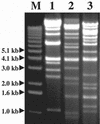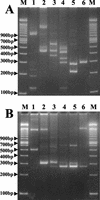Characterization of six Leuconostoc fallax bacteriophages isolated from an industrial sauerkraut fermentation
- PMID: 12406737
- PMCID: PMC129880
- DOI: 10.1128/AEM.68.11.5452-5458.2002
Characterization of six Leuconostoc fallax bacteriophages isolated from an industrial sauerkraut fermentation
Abstract
Six bacteriophages active against Leuconostoc fallax strains were isolated from industrial sauerkraut fermentation brines. These phages were characterized as to host range, morphology, structural proteins, and genome fingerprint. They were exclusively lytic against the species L. fallax and had different host ranges among the strains of this species tested. Morphologically, three of the phages were assigned to the family Siphoviridae, and the three others were assigned to the family Myovidae: Major capsid proteins detected by electrophoresis were distinct for each of the two morphotypes. Restriction fragment length polymorphism analysis and randomly amplified polymorphic DNA fingerprinting showed that all six phages were genetically distinct. These results revealed for the first time the existence of bacteriophages that are active against L. fallax and confirmed the presence and diversity of bacteriophages in a sauerkraut fermentation. Since a variety of L. fallax strains have been shown to be present in sauerkraut fermentation, bacteriophages active against L. fallax are likely to contribute to the microbial ecology of sauerkraut fermentation and could be responsible for some of the variability observed in this type of fermentation.
Figures




References
-
- Ackermann, H. W. 2001. Frequency of morphological phage descriptions in 2000. Arch. Virol. 146:843-857. - PubMed
-
- Adams, M. H. 1959. Bacteriophages. Interscience Publishers, New York, N.Y.
-
- Allison, G. E., and T. R. Klaenhammer. 1998. Phage resistance mechanisms in lactic acid bacteria. Int. Dairy J. 8:207-226.
-
- Arendt, E. K., and W. P. Hammes. 1992. Isolation and characterization of Leuconostoc oenos phages from German wines. Appl. Microbiol. Biotechnol. 37:643-646.
Publication types
MeSH terms
Substances
LinkOut - more resources
Full Text Sources
Other Literature Sources

